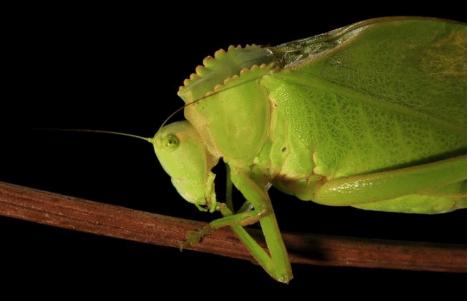What did the katydids do when picking up bat sounds?

Steirodon stalii
Credit: Laurel Symes
When predator and non-predator cues are similar in the same habitat
Ecosystems can be incredibly complex, with many interacting species. In many habitats, predators shape they behavior of prey and prey shape the behavior of predators. This paper provides a detailed look at the predator-prey relationship between bats and katydids, a group of insects related to crickets and grasshoppers.
Some species of bats hunt katydids by eavesdropping on their mating calls. However, katydids aren’t defenseless. Many species of katydids have ears that can hear the ultrasonic echolocation calls of bats. In some habitats, katydids stop calling when they hear the echolocation calls of bats. We studied katydids in Neotropical forests and predicted that they would stop calling when they heard the echolocation calls of approaching bats. What we found was a surprise – most of the katydid species continued calling even when hearing the echolocation calls of predatory eavesdropping bats.
In Neotropical forests, there are many species of bats. Some of these bats eat fruit and others catch flying insects. Most of these bat species are no risk to a perched, singing katydid. However, all of these bats produce echolocation, so while the forest is full of echolocation calls, less than 4% of those calls come from bats that might eavesdrop on katydid calls. For a katydid, this means that calling is very risky, but because there are so many bats producing echolocation calls, if katydids stop singing when they hear echolocation, they would have few opportunities to attract a mate.
By measuring the neural activity from their ears, we know that katydids are capable of hearing bats, but most of the species that we studied sing at the same rate, regardless of whether they are hearing bats. Most of the species that we studied have a more proactive strategy, using very short, very rare calls. Many species produce very little sound…less than two seconds per insect per night!
This is a cool example of how the evolution of predator-prey relationships is affected by other species in the environment, underscoring the complex and interconnected dynamics of natural ecosystems.
###
Symes LB, SJ Martinson, CE Kernan, and HM ter Hofstede. Sheep in wolves’ clothing: prey rely on proactive defences when predator and non-predator cues are similar. Proceedings of the Royal Society B: Biological Sciences https:/
Media Contact
All latest news from the category: Life Sciences and Chemistry
Articles and reports from the Life Sciences and chemistry area deal with applied and basic research into modern biology, chemistry and human medicine.
Valuable information can be found on a range of life sciences fields including bacteriology, biochemistry, bionics, bioinformatics, biophysics, biotechnology, genetics, geobotany, human biology, marine biology, microbiology, molecular biology, cellular biology, zoology, bioinorganic chemistry, microchemistry and environmental chemistry.
Newest articles
Faster, more energy-efficient way to manufacture an industrially important chemical
Zirconium combined with silicon nitride enhances the conversion of propane — present in natural gas — needed to create in-demand plastic, polypropylene. Polypropylene is a common type of plastic found…

Energy planning in Ghana as a role model for the world
Improving the resilience of energy systems in the Global South. What criteria should we use to better plan for resilient energy systems? How do socio-economic, technical and climate change related…

Artificial blood vessels could improve heart bypass outcomes
Artificial blood vessels could improve heart bypass outcomes. 3D-printed blood vessels, which closely mimic the properties of human veins, could transform the treatment of cardiovascular diseases. Strong, flexible, gel-like tubes…




















